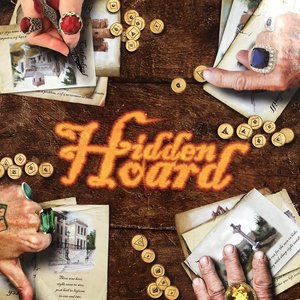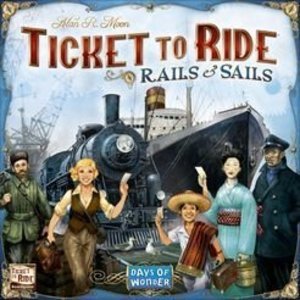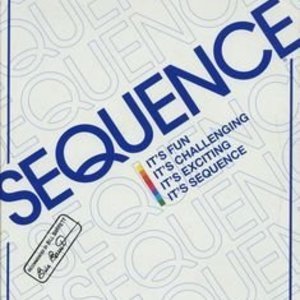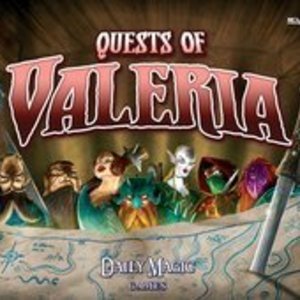
What Do You Meme?
Tabletop Game Watch
Party card game for friends for the social media generation. Think you've got what it takes to...

Truth Be Told
Tabletop Game
Truth Be Told is a revealing laugh-out-loud, pretend to know your friends party game! Each round one...

The Resistance
Tabletop Game Watch
The Resistance is a game where players attempt to deduce one another's identities. The setting of...

Hidden Hoard
Tabletop Game Watch
HiddenHoard is a traditional board game of chance and skill for up to six pirates. By a process of...

Ticket to Ride: Rails & Sails
Tabletop Game
Ticket to Ride: Rails & Sails is a standalone game with a double-sided board, the largest used in...

Monopoly Fortnite Edition
Tabletop Game
In this thrilling fortnite edition of the MONOPOLY game, players claim locations, battle opponents,...

Broken (Reflections, #1)
Book
Adri Paige is too busy dealing with the emotional fallout from losing half of her family to deal...
Young Adult Paranormal Romance Shifters
Purple Phoenix Games (2266 KP) rated Quests of Valeria in Tabletop Games
Jun 12, 2019
A royal King may rule the city of Valeria, but we all know who really is responsible for the prosperity of this kingdom – it’s YOU, the Guild Masters! Your hard work behind the scenes (providing work for Citizens, and overseeing the completion of various Quests) has helped turn Valeria into the thriving epicenter of life and commerce that it is today! Make sure you keep up the good work, because if you don’t, another Guild Master will jump at the opportunity to outperform you and win the favor of the King!
Quests of Valeria, a game of card drafting and hand management, pits players against each other as they try to hire Citizens to complete Quests and earn Victory Points. Each Quest requires certain Citizen roles and Resources to be completed, so strategy is key! Work efficiently, or another Guild Master could swipe a Citizen or Quest right out from under you! On your turn, you will take 2 actions from these listed: Draw, Hire, Reserve, or Quest. Citizen and Quest cards sometimes have special powers that, when played, allow you to take bonus actions on your turn. The game continues until a player has completed their 5th quest, and then all players count up their Victory Points. The player with the highest score is the winner! In solo play, the game ends when either the Citizen or Quest card deck is completely depleted – the solo player then counts up their Victory Points and tries to beat their personal best score!
As a solo game, Quests of Valeria is played almost exactly the same way, with one main gameplay difference. That difference has to do with the setup and handling of the available Citizen and Quest cards. In group play, Citizens and Quest cards remain in the game until their are either hired, completed, or actively discarded. In solo play, at the end of each turn, the Citizen and Quest cards at the furthest left side of the Tavern Line (play area, see photo below for reference) are discarded permanently from the game. All other cards shift one or more spaces as far left as possible in the Tavern Line and any remaining empty slots are refilled from their respective draw decks. This puts a time limit on how long cards remain in the game without being hired/completed. It really forces you to strategize which Citizens to hire and when since they only appear for a finite amount of time. The same goes for Quests – each turn pushes Quests closer to elimination from the game, so you must act quickly and efficiently to complete as many as you can before they are discarded.
I really like the idea of the shifting Tavern Line in solo play. The game would be so easy without it – there would be no rush to do anything and no real strategy involved since I could just bide my time until I have the appropriate Citizens to complete each Quest. With the shifting line, I do have to come up with an ever-changing strategy. I can’t just focus on one Quest – I have to be looking ahead to see what I need for the next quest and how long I have to complete that one too.
My only dislike of this game is that sometimes it can be slow-going getting your Guild up and running. Sometimes the Citizens and Resources I need just aren’t showing up in the Tavern Line (thanks to my awful card shuffling, I’m sure) and I just get to watch those Quests make their way through the line towards the discard pile. And then usually with my luck, I discard precious cards from my hand to Hire a Citizen that I was waiting for only to have all of those Quests slowly replaced by Quests for the Citizens that I was passing on! Since I can only have a maximum of 8 Citizens in my Guild at any given time, I can’t just recruit everybody until I get a Quest that needs those people. It’s a balancing act for sure, and it’s one that I haven’t quite mastered. I’m sure that once I figure out a better strategy for handling this type of situation, I’ll enjoy the game more. But for now, these stand-stills have me stumped.
Overall, I enjoy Quests of Valeria as a solo game. It requires a decent amount of strategy, and the more I play it, the more I like it. There’s no single strategy for success, and I like to try out different ones with each game – do I try to finish as many easy Quests as possible (fewer VPs each, but more Quests overall), or do I save up my Citizens and go only for the big Quests (lots of VPs, but also lots of required Citizens/Resources)? There’s not a right answer, and I enjoy being able to adapt my strategy to the cards currently in play. For such a simple game (Hire Citizens, complete Quests), Quest of Valeria keeps me engaged the entire time. It’s easy to learn, fast to play, and strategic enough that it keeps you hooked. Give it a try as a solo game – it might surprise you!
https://purplephoenixgames.wordpress.com/2019/03/28/solo-chronicles-quests-of-valeria/


